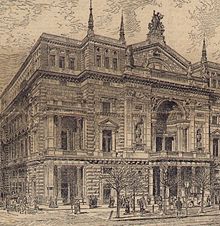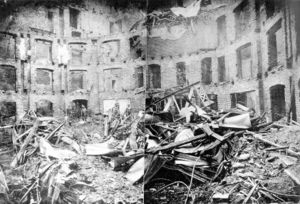
Ringtheater
Encyclopedia

Vienna
Vienna is the capital and largest city of the Republic of Austria and one of the nine states of Austria. Vienna is Austria's primary city, with a population of about 1.723 million , and is by far the largest city in Austria, as well as its cultural, economic, and political centre...
, Austria
Austria
Austria , officially the Republic of Austria , is a landlocked country of roughly 8.4 million people in Central Europe. It is bordered by the Czech Republic and Germany to the north, Slovakia and Hungary to the east, Slovenia and Italy to the south, and Switzerland and Liechtenstein to the...
. It was located in the First District (Bezirk
Bezirk
Bezirk means "district" in German and can refer to:* The primary Subdivisions of East Germany from 1952* The districts of Austria* Some of the Districts of Switzerland...
I), Schottenring 7. It was destroyed in a fire in 1881, and today the site is the federal headquarters of police for Vienna.
Construction

Albin Swoboda, Sr.
Albin August Heinrich Emil Swoboda was an Austrian operatic tenor, actor, and opera director of German birth. One of the most famous opera singers of the "Golden Age" of Viennese operetta, he was a leading tenor and dramatic stage actor at the Theater an der Wien from 1859-1878...
as an 'Opéra Comique', antithetical to the "seriousness" of the Vienna State Opera
Vienna State Opera
The Vienna State Opera is an opera house – and opera company – with a history dating back to the mid-19th century. It is located in the centre of Vienna, Austria. It was originally called the Vienna Court Opera . In 1920, with the replacement of the Habsburg Monarchy by the First Austrian...
, then called the Court Opera ('Hofoper'). However in September 1878, the focus was shifted to spoken plays, German and Italian opera and variety
Variety show
A variety show, also known as variety arts or variety entertainment, is an entertainment made up of a variety of acts, especially musical performances and sketch comedy, and normally introduced by a compère or host. Other types of acts include magic, animal and circus acts, acrobatics, juggling...
, and the name was changed to the "Ringtheater".
The Ringtheaterbrand

Les contes d'Hoffmann
Les contes d'Hoffmann is an opéra by Jacques Offenbach. The French libretto was written by Jules Barbier, based on short stories by E. T. A...
. The "Ringtheaterbrand" ("Ringtheater Fire") totally destroyed the theatre, and killed at least 384, according to official figures. (The following year, a new law was passed, regarding the outfitting and safety provisions, including safety curtain
Safety curtain
A safety curtain is a fire safety precaution used in large proscenium theatres. It is usually a heavy fibreglass or iron curtain located immediately behind the proscenium arch. Asbestos-based materials were originally used to manufacture the curtain, before the dangers of asbestos were discovered...
s, outwards-opening doors and fireproofing of the set).
The site after the fire
A so-called 'Sühnhaus' was built on the site of the Ringtheater out of the Emperor's private funds; it was a private residence, which supported worthy causes. This was badly damaged in 1945 and eventually fell down in 1951; between 1969 and 1974, an office block was erected on the site, in which the federal headquarters for police in Vienna and the general inspectorate of the federal security guards, and the now police commandos are housed. The fire is commemorated on a plaque on the police building. The Attic styleAttic style
In classical architecture, the term attic refers to a story or low wall above the cornice of a classical façade. This usage originated in the 17th century from the use of Attica style pilasters as adornments on the top story's façade...
statues, which had stood on the pilaster
Pilaster
A pilaster is a slightly-projecting column built into or applied to the face of a wall. Most commonly flattened or rectangular in form, pilasters can also take a half-round form or the shape of any type of column, including tortile....
s, are now in the Pötzleinsdorfer Schlosspark.
Sources
Most of the information in this article is taken from the German Wikipedia article.See also
- The novel inspired by the Ringtheater fire, My Heart Was Awake at: http://myheartwasawake.blogspot.com/

